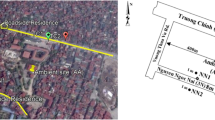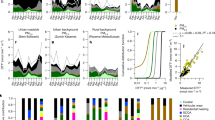Abstract
This study uses a combination of data from U.K. monitoringstations and from modelling undertaken with the U.K.Meteorological Office's NAME Model to investigate therelative influences of primary and secondary particulateson total PM10 levels at sites in the United Kingdom. Co-located PM10 and sulphate aerosol measurementsindicate that sulphate has a disproportionately largeinfluence on the variation of PM10 levels incomparison to its contribution to their total mass.Comparisons of measured PM10 at urban centre, roadsideand rural sites suggest that local primary sources havevery little influence on daily mean levels. NAME has beenused to model both primary particles and sulphate aerosolfrom sources across the whole of Europe. The discrepanciesbetween modelled and observed PM10 suggest that coarseparticles, such as windblown dust and resuspended roaddust,may comprise a very large, if not dominant, proportion ofobserved PM10 levels. The apparently minor role ofprimary particles (especially locally-sourced ones) raisesa number of issues regarding the suitability of current U.K.and European legislation to addressing the particle problem.
Similar content being viewed by others
References
APEG (Airborne Particles Expert Group): 1999, Source Apportionment of Airborne Particulate Matter in the United Kingdom, Department of the Environment, Transport and the Regions, London.
CEHOGNI: 1999, Air Quality in Northern Ireland, Chief Environmental Health Officers' Group for Northern Ireland, Belfast, Northern Ireland.
DETR: 1999, Review of the United Kingdom National Air Quality Strategy, Department of the Environment, Transport and the Regions, London, U.K.
DoE: 1997, The United Kingdom National Air Quality Strategy, Department of the Environment and the Scottish Office, London.
Dixon, J. and Middleton, D. R.: 2001, ‘An Analysis of the Meteorology Associated with Air Pollution Episodes in the U.K.’, 3rd International Conference on Urban Air Quality, Extended Abstracts, Institute of Physics, Loutraki, Greece.
Doyle, M., Chatterton, T. and Dorling, S. R.: 2001, ‘An Examination of PM10 and PM2.5 in a Busy Shopping Area in Norwich, U.K.’, 3rd International Conference on Urban Air Quality, Extended Abstracts, Institute of Physics, Loutraki, Greece.
EMEP: 1997, Transboundary Air Pollution in Europe, MSC-W, Norwegian Meteorological Institute, Status Report 1/97, Oslo, Norway.
EPAQS: 2001, Airborne Particles: What is the Appropriate Measurement on Which to Base a Standard?, Expert Panel on Air Quality Standards, London, U.K.
Green, D., Fuller, G. and Barratt, B.: 2001, ‘Evaluation of TEOM 'correction factors' for assessing the EU Stage 1 limit values for PM10, Atmosph. Environ. 35(14), 2589–2593.
King, A. and Dorling, S., 1997, ‘PM10 particulate matter – The significance of ambient levels’, Atmosph. Environ. 31(15), 2379–2381.
King, A., Jones, A., Dorling, S., Merefield, J., Stone, I., Hall, K., Garner, G., Hall, P. and Stokes, B.: 1999, ‘Study for Particulate Sampling, Sizing and Analysis for Composition’, Report Commissioned by the Department of Trade and Industry (Energy Technology Support Unit), ETSU N/01/00049/REP, IMC Technical Services Ltd, available at http://www.etsu.com/en_env/html/rep49.html.
Malcolm, A. L., Derwent, R. G. and Maryon, R. H.: 2000, ‘Modelling the long-range transport of secondary PM10 to the U.K.’, Atmosph. Environ. 34, 881–894.
Malcolm, A. L. and Manning, A. J.: 2001, ‘Testing the skill of a lagrangian dispersion model at estimating primary and secondary particles’, Atmosph. Environ. 35(9), 1677–1685.
Rodríguez, S., Querol, X., Alastuey, A., Kallos, G. and Kakaliagou, O.: 2001, ‘Saharan dust contributions to PM10 and TSP levels in Southern and Eastern Spain’, Atmosph. Environ. 35(14), 2433–2447.
Ryall, D. B. and Maryon, R. H.: 1996, The NAME 2 Dispersion Model: A Scientific Overview,U.K. Meteorological Office, Turbulance and Diffusion Note 217b, U.K.
Ryall, D. B. and Maryon, R. H.: 1998, ‘Validation of the U.K. Met. Office's name model against the ETEX dataset’, Atmosph. Environ. 32(24), 4265–4276.
Stedman, J.: 1997, ‘A U.K.-wide episode of elevated particle (PM10) concentration in March 1996’, Atmosph. Environ. 31(15), 2381–2383.
TNO: 1997, Particulate Matter Emissions in Europe in 1990 and 1993, TNO, TNO-MEP-R96/472, The Netherlands.
Author information
Authors and Affiliations
Rights and permissions
About this article
Cite this article
Chatterton, T., Dorling, S., Lovett, A. et al. The Relative Influences of Primary and Secondary Particulates to Urban Air Quality in the United Kingdom. Water, Air, & Soil Pollution: Focus 2, 173–187 (2002). https://doi.org/10.1023/A:1021327132509
Issue Date:
DOI: https://doi.org/10.1023/A:1021327132509




